| Cardiac | |
|---|---|
| GI | |
| Bone | |
| GU | |
| Neuro | |
| Peds | |
| Faculty | |
| Student | |
| Quizzes | |
| Image DDX | |
| Mobile | |
| |
Misc |
| Videocasts |
What's the most likely diagnosis?
- 36 year-old undergoing retrograde pyelogram

Left Kidney-Retrograde Pyelogram
- Renal laceration
- Hepato-renal fistula
- Pyelovenous backflow
- Retroperitoneal fibrosis
- Staghorn calculus
Additional Image - None
![]()
Additional Image
.
.
None
.
![]()
Answer:
.
3. Pyelovenous backflow
.
.
More (Click Discussion Tab)
Pyelovenous Backflow
General Considerations
- Refers to the retrograde flow of contrast material out of the intrarenal collecting system due to a small rupture of a calyceal fornix
- Almost always seen with increased pressure in the collecting system such as from
- Retrograde pyelography
- Majority of cases
- Antegrade pyelography (urogram), due to obstruction of the collecting system almost always by a ureteral calculus
- Less common
- Retrograde pyelography
- Obstruction is usually in the ureter
- Rupture decompresses collecting system
- Rarely, from vesico-ureteral reflux
.
This Week
This video podcast reviews the causes of some of the more common pitfalls in radiology and suggests how to avoid them; there is a mini-quiz included |
A trim mobile version for your PDA or internet-enabled smartphone with handy lists of differential diagnoses, most commons and more
|
Key points on recognizing the most common fractures and dislocations |
Basic CT imaging of the brain focusing on the findings of cerebrovascular accidents |
The top diagnostic imaging diagnoses that all medical students should recognize according to the Alliance of Medical Student Educators in Radiology |
Recognizing normal and key abnormal intestinal gas patterns, free air and abdominal calcifications |
Some of the fundamentals of interpreting chest images |
| LearningRadiology.com |
is an award-winning educational website aimed primarily at medical students and radiology residents-in-training, containing lectures, handouts, images, Cases of the Week, archives of cases, quizzes, flashcards of differential diagnoses and “most commons” lists, primarily in the areas of chest, GI, GU cardiac, bone and neuroradiology. |


